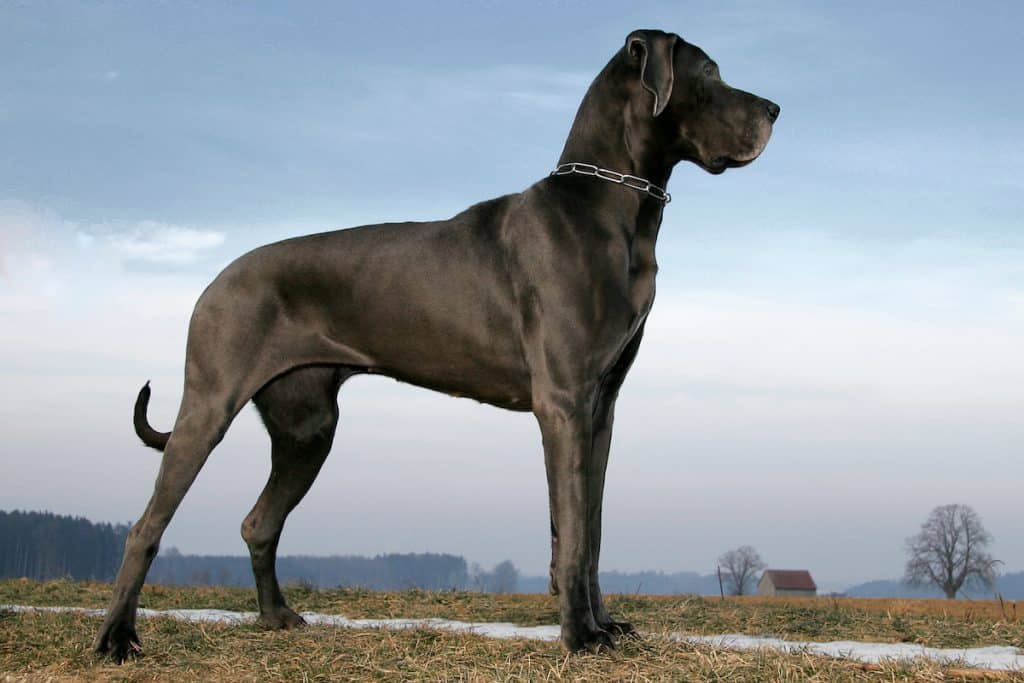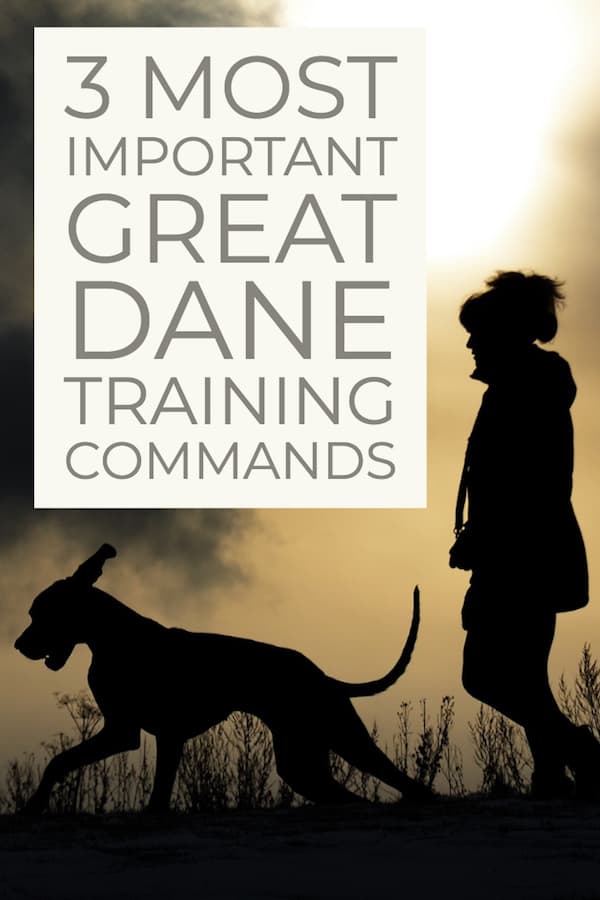
Great Danes are physically impressive dogs, but an untrained Great Dane can be more than a handful to deal with! Their size and strength present unique challenges that require a dedicated approach to training from a young age to ensure safety for all.
A well-trained Great Dane is guaranteed to lead a safer, happier, and more fulfilling life than one who is untrained. The saying “a well-trained dog is a happy dog” exists for a reason!
With that in mind, let’s jump in to learn more about the benefits of training, Great Dane training specifics, and the 3 most important commands!
Benefits of Proper Training
- Safety – A dog that is easy to manage and responds to command is far safer than their untrained counterparts. In the United States alone, 1.2 million dogs are killed on roads each year. Training them to come (recall) when called could very well save their life. There are many examples that could also be used to illustrate this example, but the point is that it’s up to you as the owner to safely direct them.
- Relationship – Dogs are supposed to be man’s best friend, right? A well-trained dog that is happy and easy to manage allows you to better appreciate and enjoy them.
- Socialization – A well-trained dog is more likely to get brought along on adventures outside the home than an untrained one. Not only do you get to enjoy more of each other’s company, but it also leads to a more fulfilling life for the dog. They will get to see and do things that an untrained dog at home would never get to experience and will love you all the more for it.
Find What Motivates Your Great Dane
While many Great Danes are utter people-pleasers, finding out what motivates YOUR Great Dane will get the best results. “Best” is relative because there are likely several approaches that will work.
However, the efficiency with which you train your Dane is still important. Faster results mean that you will be less likely to get frustrated or discouraged with training.
Your Great Dane will also be more likely to enjoy the training when you’re enjoying it as well. While considered to be of average intelligence, their pleasing nature makes them a generally easy-to-train breed.
Top Dane Motivators
- Attention – Great Dane’s LOVE attention. So much, in fact, that praise and affection are all that is needed to train many. Positive actions can be rewarded with enthusiastic phrases of “good girl!” or “good boy!” plus their favorite way to be pet, rubbed, scratched, etc…
- Food – Food is a common training reward for many breeds but not always the biggest motivator for Danes. Food rewards are not meant to replace meals or count towards a significant source of daily calories, but instead small treats to encourage good behavior. However, the key to effectiveness with food is to find high-value treats! Everyday run-of-the-mill dog treats simply will not do. These need to be the kind that will have your Dane’s mouth watering just thinking about them. Not that there’s a shortage of that already.
- Toys – For some Great Dane’s, a favorite toy can be utilized as a training implement. Its use will be similar to that of food, as the toy would only be provided as a reward for good behavior.

Top Great Dane Training Commands
Below I will cover the three most important commands in Great Dane training. Focus on getting very good at an individual command before introducing a new one.
It’s much easier for them to learn one at a time rather than attempt to learn several commands in parallel. This will only lead to confusion and frustration for everyone.
Make sure to end every training session with fun playtime. This gives you and the dog time to unwind and ensures that sessions always end on a high note.
While many sessions will feel very productive, you’re bound to have a few not-so-great ones. Much like crate training, you want them to associate it with a positive experience.
Clearly, this is not an exhaustive list of every training command out there! However, they will provide a fantastic foundation for training. You can always teach new commands after these basics have been mastered.
All training should occur with the dog on a leash to provide a greater level of control. This will help prevent mistakes or “bad reps” that need to be undone. Only progress to the off-leash variations once they have mastered them on-leash.
Sit
Why It’s Important
While it may be considered to be very basic, sit is the foundation of all training. It teaches your dog that good behavior equals reward and sets them up for later success with more advanced commands.
It also serves as a base form of self-control. A sitting dog is less likely to jump up and knock someone over, dart across the street, or bolt out a front door.
Sit should also act as a form of “please”. Sit to eat, sit to get a treat, sit to go outside and play. See how all of these outcomes are rewards for the act of sitting?
This self-rewarding behavior creates a compelling positive feedback loop that pays dividends later for all training.
How To Teach “Sit”
- Start by getting your dog’s full attention. This is best accomplished by standing directly in front of them so that they can see you.
- Show them the motivator so they understand what’s at stake i.e. the treat or favorite toy.
- Slowly move the item from in front of their nose, and then just above their head. It should be close enough for them to reach without jumping, but do not let them have the item.
- This movement should cause their heads to raise, and their rear end to touch or have gotten very close to the floor.
- If their rear end is not touching the floor, gently guide it down with your opposite hand until it reaches. Due to their lanky build, they physically may not be able to touch the rear to the floor. If they’ve gone done as far as physically possible then that counts as their sit.
- In the event that they try to back up a few steps to reach the treat, you can place them near a corner or other physical object that limits any backward movement.
- As soon as their rear end reaches the floor, say “SIT”. This should be spoken in a clear, confident tone, that could be heard by someone standing fifteen feet away. Refrain from using any other words as you want to ingrain the action of sitting with that word alone.
- Reward them with their motivator and provide lavish love and praise.
- After rewarding them, make sure to release them from the sit position. This is important because it provides a clear before and after picture as to what “sit” means. You can persuade them to move out of the sit by giving them a nudge while backing away and encouraging them to come to you. The release should also be coupled with a standard release verbal command. Common ones are “Ok”, “Release”, or “Free”. Pick one term and use it as the release for all commands.
- Once they start catching on, skip steps 3-4 and begin with the sit command. At this point, they will know what to do once they hear the command and drop straight into a sit.
- Make sure to always guide them down into a full sit as it can take Great Danes a while to get used to this position.
- Repeat for up to 15 minutes, or when they get tired and are no longer able to focus. Don’t forget to wrap up the session with some fun free playtime!
Come (Recall)
Why It’s Important
Also known as recall, come is quite possibly the most important command for safety. The ability to recall your Great Dane from any distance could very well save their lives one day.
It can also allow them more freedom off leash knowing that you will always be able to recall them to you should the need arise.
How To Teach “Come”
- Start by repeating steps 1-2 of sit.
- Step back a couple of feet to create some separation between yourself and the dog. This can be as little as three feet when you first begin training recall.
- Clearly and confidently say “COME”.
- If they haven’t already started moving towards you, give their leash a gentle tug as a hint.
- As they make progress towards you, reel in the leash to pick up any slack. Doing so will act as prevention for any detours should they get distracted on the return. Their path back should be straight, and you can use the leash to help guide as needed.
- Lowering yourself down to a squat or kneeling position puts you on their level and can help ramp up their excitement in speedily returning to you.
- The recall is deemed complete once they have come all the way back to physically touch you. Now, this doesn’t mean that you should allow or encourage them to run into you, but they should return until they have physically touched you.
- Once this happens, reward them with their motivator and provide lavish love and praise.
- After this has been done you can release them, take a very short break, and resume training the command.
- While it can be easy initially, recall gets exponentially tougher as you move further away. Slowly increase the distance to build their confidence. The use of a long line leash is critical for distance training to avoid mistakes.
- Due to its safety implications, recall is a command that you should practice tirelessly until mastery has been demonstrated from ultra-long distances such as a couple hundred feet.
Down
Why It’s Important
Down is extremely useful for a number of reasons. Like sit, down acts as a pause button for any pesky behaviors. By laying prone they are far less likely to get into mischief due to a relaxed state.
This is especially useful for public outings where you need them to behave and stay out of the way such as at a café.
Sit can act as a helpful transition command for training down. Once they understand the concept of down you can skip the intermediate sit and go straight into a down position.
How To Teach “Down”
- Start by repeating steps 1-2 of sit.
- Clearly and confidently say “DOWN”.
- Slowly move the item from in front of their nose, and then slowly down toward the ground and then along the floor directly away from them. This motion away from them should be in parallel to their body, not side to side.
- If they do not follow the item down to the ground, you can gently place your hand on their shoulder to encourage the downward progress.
- Once their full-body reaches the ground they have reached the down position. This includes their elbows, belly, and butt.
- At this point, you can reward them with the motivator and provide love and praise.
- Release them from down, take a short break, and resume practice!
Advanced Variations of These Commands
Once your Great Dane has mastered the basic versions of these training commands, you can increase their difficulty with modifiers. Common ways to do this include:
- Duration – Lengthen the duration of commands e.g. stay in sit or down for 1, 2, or 5 minutes.
- Distance – Issue commands from a distance e.g. sit from 15, 25, or 50 feet away.
- Distraction – Purposely incorporate distractions such as facing a different direction while giving the command.
Great Dane Training FAQs
When should I start?
This one’s easy – you should start as soon as you can!
The day your Great Dane comes home should be viewed as the first day of training! This is helpful for many reasons:
- You start immediately start building the habit of training together. The usage of the term “together” is important here as the training process is applies to both Dane and owner.
- Training takes persistence. By starting immediately, you start getting “good reps” before incorrect responses are learned. The process of unteaching is far more difficult than getting it right the first time.
- Time is not on your side. Great Dane’s grow at a remarkable rate, and you should strive to have them trained while you still stand a chance at physically maneuvering them. It’s much easier to help position them into the proper position such as a sit or down while they’re smaller.
How often and how long should we train?
Consistency is key to success. The more frequently you can reinforce training the better. As an analogy, consider the process of learning a new language.
If you only practice the new language once per week, it’s going to take a very long time to master it. Whereas if you were to spend just 30 minutes each day practicing the language, you would make much faster progress.
The process of learning requires repetition to develop mastery. While I described this as an analogy, it’s actually quite similar to what’s happening. You don’t speak dog, and they don’t speak human. Training is the dog equivalent of learning a new language!
Puppies have short attention spans and are easily distracted. However, this can be overcome by performing shorter training sessions. Aim to perform two training sessions per day lasting fifteen minutes each.
These sessions should be spaced out appropriately to give the dog time to rest. Example training schedules could be morning and evening, morning and lunch, lunch and evening, etc…
While it may be tempting to lump these two sessions together, the quality of training usually goes down after 15 minutes. Shoot for the quality of training time over quantity. If that means you have to cut a session short, then so be it.
Sessions should also be cut short if they get tired and struggle to follow commands. Be happy for the good work that they did put in and enjoy playing for the remainder of the time.
Does it matter where we train?
Yes, location matters.
Pick a location where they feel safe and comfortable and has a limited number of distractions.
Some distractions are actually beneficial as they teach your dog to ignore them, but it shouldn’t be an overwhelming experience that makes focusing impossible.
If you plan on training at home, make sure to let others know when you will be training so that they don’t try to play with the dog during the session.
Do I need anything for training?
Aside from finding what motivates them, you should also have a few other tools at your disposal. The first is a standard 6-foot non-retractable leash. Non-retractable is key as they provide more control during the training process.
A second extremely helpful tool is a 50-foot long line leash. These are fantastic for maintaining connection and control during distance command training.
You can pick up this fantastic long line leash here that will serve you well for many years!
Training Wrap-Up
While the bulk of the training will occur in the first couple of years of a Great Dane’s life, it should be viewed as a lifelong quest. Even if you choose to never teach them another command, it will always be up to you to continue reinforcing those that have already been taught.
Training should be a fun way for you to bond and develop your relationship with them. It also ensures that you will get to share more experiences together and lead happier more fulfilling lives.


…..and do not jump out the truck window! I’m talking to you Martok!
Thanks for the tips, we have adopted an older great Dane, he’s nearly 5 and had 2 previous homes. He’s generally very good until he sees another dog when we are out. Then barks and pulls towards the other dog, we’re not sure if he wants to play or attack. He lives white happily with our other dogs so have you any tips?
I love reading all the information .we have George , he is 2 years old ,and great Great Dane. He just gets super excited when friends and family come over, will sit and stay but as soon as they walk in door he won’t stay seated . All over them with excitement. What are your suggestion .would be appreciated.
Hi I have a grea Dane puppy she keeps biting me but not my partner if I hold her lead she bites the lead and trys to go for my legs playing but if my partner takes the lead she behaves can you suggest anything to help
I adopted a 5 year old Great Dane and I can’t get her into my SUV, I have purchased the ramp, the stairs, and tried treats and nothing works. I wonder if it because it is high but any suggestions would help.
We have a Great Dane that turned 1 year old this January. We recently adopted 2 new cats and he won’t stop chasing after them and barking at them. We had 2 cats before we got him, and he leaves those cats alone. Any Suggestions?
My Great Dane has learned sit, though there are times when I command sit, and not down, he goes right into a down position. While it seems okay to me, as he is behaving in a “I’m supposed to stay right here”, should I teach him to differentiate the two commands?
Yes, they’re different commands but at the same time he’s listening and trying so that’s a great start! You can work with him to differentiate, but it’s not a deal breaker as far as general obedience training goes in my opinion.
Great read.thank you so much.i always learn something new with these articles.